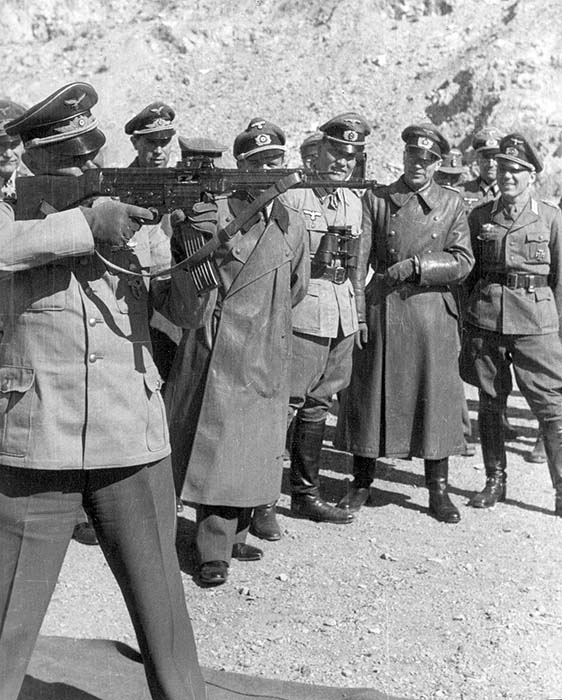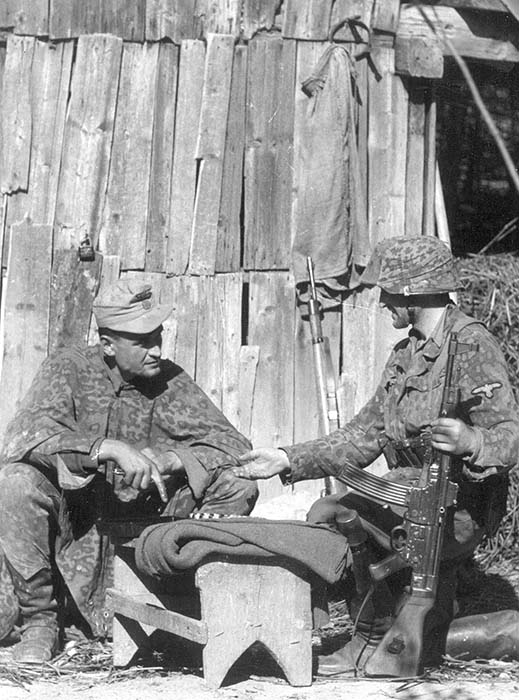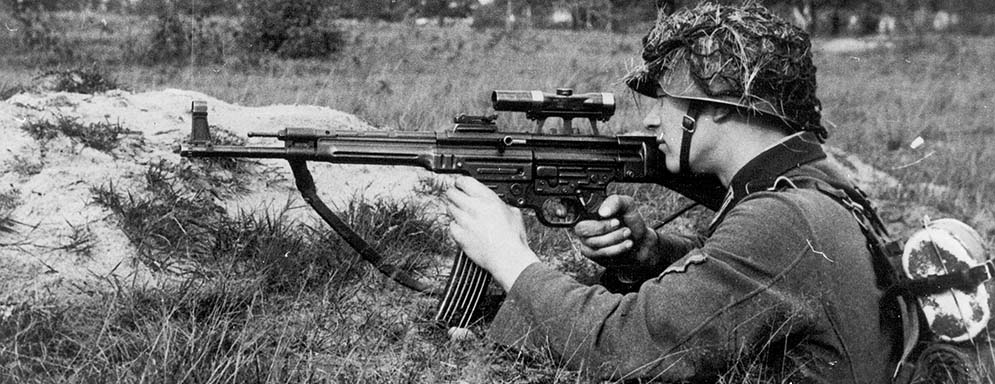By Robert Cortese
Evaluating the Sturmgewehr 44’s combat record in World War II poses a more difficult problem than similar studies regarding the battlefield performance of the AK 47. This is due to the limited distribution, by World War II standards, of the StG 44 to Germany’s infantry forces in comparison with more widely deployed arms such as the MP-40 and Kar 98. The total production of all versions of the StG 44 amounted to only 425,977 completed rifles by war’s end, and not all of those weapons found their way into the hands of Hitler’s men. But the firepower and morale effects imparted by the StG 44 on those German troopers fortunate enough to receive sufficient numbers of that superb rifle can be measured. I have done this by contrasting the battlefield performance and results of units armed with more than a few token StG 44s with similar units that were either entirely or virtually unequipped with the world’s first true assault rifle.
We will focus on two significant campaigns to determine the Sturmgewehr’s impact on the fighting therein. These are the German Ardennes Offensive of December 1944 (usually referred to as the Battle of the Bulge) and the Soviet operations in North Germany that culminated in the Battle of Berlin in 1945. These battles provide enough evidence to prove superiority, if not outright dominance, of the StG 44 when compared with the other infantry arms of World War II.
Very few Sturmgewehrs made their way into the hands of the German infantry that were poised to lash out at scattered defending American formations on the eve of the Battle of the Bulge. In way of example, the Second Battalion of the 26th SS Panzer Grenadier Regiment counted only 11 MP-43s (an alternate designation for the StG 44) among its small arms inventory on 16 December 1944. This low number is remarkable given the high logistical priority assigned to the SS units earmarked for the assault. Other non-Wehrmacht infantrymen also received small quantities of assault rifles prior to 16 December. The most significant distribution of these arms fell to the two parachute infantry divisions that participated in the Battle of the Bulge. These were the 3rd and 5th Fallschirmjaeger Divisions.
These Fallschirmjaeger were not the killer elite that fleshed out the Luftwaffe’s parachute infantry battalions earlier in the war. Many of the men that had done such damage to Allied divisions at Cassino and Normandy had been killed, crippled or reassigned to rear area duty due to the stress on themselves by the end of 1944. Their replacements were utterly unwilling volunteers combed from Luftwaffe anti-aircraft and supply outfits. Above all, the operational level leadership of the Fallschirmjaeger Divisions that maintained the paratroops cohesion throughout all sorts of adversity was missing as the skilled officers and NCOs had to be replaced with inexperienced men. Yet both divisions had capable men at their helms. Generals Walter Wadehn and Sebastian Heilmann commanded the 3rd and 5th Fallschirmjaeger Divisions respectively.
The Generals soon found that there were not enough ersatz paratroopers to man their divisions. Troop strength rosters listed 12,474 men assigned to the 3rd and 16,432 men serving in the 5th. The 5th Fallschirmjaeger Division’s total includes the attachment of an artillery unit and the 11th Fallschirmjaeger SturmGeschutz (StG) Brigade. Both of these formations fought alongside the paratroopers throughout the campaign. The attached artillery unit brought the 5th Divisions artillery complement up to 51 towed anti-tank guns, 36 light, 12 medium and 24 rocket artillery pieces. The main combat power of the 11th StG Brigade resided in its 18 StG III self-propelled guns. The StG III featured a 75mm gun that was capable of defeating any British or US tank. In contrast, the 3rd Fallschirmjaeger had only 30 towed anti-tank guns and 25 howitzers, 15 of which were light and 10 medium. The 3rd did not receive any armor support in the form of its own StGs. To compensate for the discrepancy now created between the divisions in artillery firepower, the 3rd was issued with additional StG 44 rifles. While sources vary, the 3rd had at least three times as many StG 44s in its inventory as did the 5th at the outset of the Battle of the Bulge. The increase in infantry firepower generated by the 3rd Division’s extra StG 44s clearly made a difference in the fighting in the Ardennes Forest, as can be seen by the following campaign description.

In rough terms, Wadehn’s men fought in the northern sector of the rapidly expanding Bulge while Heilmann’s troopers did battle along the southern edge of the battlefield. Prior to the opening on the main battle, the 3rd Fallschirmjaeger Division successfully defended the town of Duren from an American attack. The US V Corps — consisting of the 2nd, 8th, 78th and 99th Divisions — butted its head against the Fallschirmjaeger defenses in and around Duren from 13 to 15 December 1944. Both German divisions were involved in the opening assaults of the Battle of the Bulge. Heilmann’s 5th Division initially arrayed itself the American 28th Division, the famous “Bloody Bucket” division of the Pennsylvania National Guard. The 28th stood its ground against the paratroopers for the first three days of the battle, and only yielded ground to the Luftwaffe men on the 19th when other advancing German forces threatened to cut them off. The poor offensive performance of the 5th Fallschirmjaeger led to the division being relegated to a defensive role astride the Arlon Highway while the SS laid siege to the US 101st Airborne Division at Bastogne.
While the intent of this defensive positioning was to relieve the exempt of the 5th Division from the intense fighting around Bastogne, the Arlon highway would soon become the focal point of the American counterattack to relieve the hard-pressed real paratroopers of the 101st. The Fallschirmjaeger initially showed skill and tenacity in defense by repulsing the US 4th Armored Division’s initial attack on 23 December 1944. But Goering’s ground forces caved in along the Arlon Highway on Christmas Day, permitting the relief of Bastogne at 1650 hours of 26 December when Company C of the 53rd Armored Infantry Battalion touched bases with the 326th Airborne Engineer Company of the 101st Division.
Shoved back from its positions south of Bastogne, the 5th found itself part of a group confronting the US IIIrd Corps. Three divisions of IIIrd Corps, the 26th, 35th and 80th, assailed this patchwork German grouping from 27 December 1944 to 3 January 1945. Heilmann’s previous nemesis, the US 4th Armored, also threw its weight into the assault. The 5th Fallschirmjaeger got help in the form of the 26th VolksGrenadier Field Replacement Battalion as well as the detachment of the crack 901st PanzerGrenadier Regiment from the Panzer Lehr Division just as the battle began. These reinforcements gave the 5th enough reserves to wrest two towns from the 34th Division in a bold counterattack on 29 December. But IIIrd Corps doggedly pressed on with its advance and gradually ground down 5th Fallschirmjaeger until it made its last desperate stand at Harlange on January 9th.
The 5th Fallschirmjaeger Division was in poor fighting condition when the 35th and 90th Divisions struck violently towards Harlange. Heilmann’s survivors were now outnumbered by approximately four to one and most of the division’s artillery had been lost in the fighting around Bastogne. If it is possible for the results of a battle to be preordained, the outnumbered, demoralised and firepower deficient men of the 5th must have known their fate as soon as the first firefights erupted around Harlange on January 9th. Two further days of hard fighting broke the FallschirmjaegerÕs will to resist, resulting in German High Command’s decision to declare the 5th Division nonexistent as a combat formation on 11 January.
Sturmgewehrs made possible a far better combat record for the 3rd Fallschirmjaeger Division in the Ardennes. After bloodying US V Corps in the aforementioned Battle of Duren, elements of the 3rd broke through American defenses south of Loshiem on December 16th. Wadehn’s men inflicted such a sharp defeat on the American 99th Division in the environs of Honsfeld on the 16th that GI’s would later refer to the battle as the “victimization” of their outfit. Of particular note, troopers of the US 14th Cavalry Group credited the “overwhelming small arms fire” administered by the advancing German parachute infantry as the major reason compelling the 14th Cavalry’s withdrawal from their defensive positions on 0730 hours of the 16th.
Elements of the 3rd fought alongside SS Obersturmbannfuhrer (Lieutenant Colonel) Jochen Peiper’s battle group at Lanzerath. The combination of Luftwaffe small arms firepower and SS heavy armor cleared Lanzerath by the 17th; one company of paratroopers accompanied Peiper as far as Stavelot in order to deliver high-density small arms fire when needed. Units of the 3rd Fallschirmjaeger Division took the towns of Modschied and Schoppen by 19 December with SS help. But other outfits of the 3rd captured Neuhaus, Heppenbach and Ambleve by the same day without assistance. Wadehn’s soldiers completed the isolation of the ill-fated US 106th Division at St. Vith when they successfully attacked Lignerville on the 20th, thereby severing the road to Malmedy.
After four straight days of victories, 3rd Fallschirmjaeger finally experienced a setback at the hands of the American 16th Division. Following up on the success at Lignerville, the vanguard of the 3rd Fallschirmjaeger was halted by coordinated American artillery fire as December 20th came to a close. Aid for the German paratroopers showed up in the form of the 12th SS Panzer Division. This unit, known as “Hitler Jugend”, was bristling with new weapons including the excellent Jagdpanther tank destroyer with its 88mm gun. The 3rd and 12th Divisions began a coordinated attack near Butgenbach on 21 December.
American main forces consisted of the 1st and 26th Divisions. The US 2nd Division, in concert with V Corps, lent its artillery assets to the defense of Butgenbach, resulting in a total of 23 artillery battalions available for the battle. This massed artillery was too much for the Germans, who consequently broke off the attack and conducted an active defense in the area northwest of St. Vith until 15 January 1945.
On that day US V Corps launched an attack to rid the St. Vith road junction of German defenders. The 3rd Fallschirmjaeger, now commanded by General Richard Schimpf, threw back several attacks over the next five days despite being greatly outnumbered by American infantry and, of the utmost importance, artillery. Schimpf’s tired troops based their defense on the Ondenval Heights and were able to use their superior small arms fire to hold this high ground despite the daily pummelling dished out by US artillery. Resistance was only overcome on 20 January when General Omar Bradley committed the 7th Armored Division, thus simultaneously clearing local German resistance and opening the road to St. Vith.

Another proof of the StG 44’s effectiveness in the Battle of the Bulge can be found in the casualties suffered by the Fallschirmjaeger divisions. Third Fallschirmjaeger lost a total of 2636 men in the battle (364 killed, 1255 wounded and 1017 missing). Losses for the 5th were 8329 men (1000 killed, 3765 wounded and 3564 missing) in the same time period. These losses amount to 21.13% and 50.69% of the starting strengths of the 3rd and 5th Divisions respectively. The catastrophic losses endured by the men of the 5th Division are astounding in light of the fact that the Division’s combat strength was theoretically far greater than that of the 3rd due to the artillery attached. Many of the 5th losses are missing. Read this as captured, as the poor small arms equipment of the 5th would tend to hinder any escape attempts made by small groups of infantry. A further drawback to true combat power of the 5th Division was the restricted terrain of the Ardennes that typically favors close combat weapons such as small arms. Hence the added artillery did not compensate for lack of assault rifles in the 5th Fallschirmjaeger Division.
American World War II veteran and military historian Trevor N. Dupuy introduced a mathematical system for evaluating troop performance in his book, Hilter’s Last Gamble (Harper Collins, New York, 1994). Dupuy almost invariably rates the performance of German troops superior to their American counterparts. Such is the case in the battles from 16 to 18 December, as the 3rd Fallschirmjaeger Division spearheads the advance of I SS Panzer Corps. Regarding the two clashes involving the 5th Fallschirmjaeger Division (16- 19 December and Harlange) however, Dupuy rates the German paratroops slightly inferior to the GIs. Given the fact that no appreciable difference existed in the quality of the converted Luftwaffe field personnel that wound up in the 3rd and 5th Divisions, and that both faced equivalent opposition (average quality US infantry and one tank division each), the difference in performance must rely on the equipment of the paratroops. It has already been demonstrated that the artillery advantages enjoyed by the 5th Division delivered less real combat power than the small arms driven firepower superiority of the 3rd. This firepower superiority can result from nothing other than the higher distribution density of StG 44s in the 3rd Fallschirmjaeger Division.
An example of the performance enhancing effect of the StG 44 on the men of a single unit exists in the battlefield record of the 33rd SS Grenadier Division. This division called “Charlemagne” and comprised of a high percentage of non-German West Europeans, was ready for its first battles just as Nazi Germany was in its death throes. The under strength division, listing at most 7000 personnel at peak strength, sported the standard late war SS squad level organization that issued one StG 44 to each squad. Thus equipped, Charlemagne was hurled headlong into the disaster that was befalling Army Group Vistula in March of 1945. In brief, the Red Army masterfully killed, captured and scattered one third of all German ground forces on the East Front at little cost to themselves in the weeks prior to the beginning of their assault on Berlin. The 33rd SS quickly fell victim to the Russians, and in a few days the Division was reduced to a standing strength of only 700 men.
The survivors were redesignated “Charlemagne Regiment” in mid-April as there could no longer be any question of this remnant being confused for a full division. Positive equipment changes accompanied the redesignation in the form of a full issue of Sturmgewehrs. All troops in each infantry squad now handled an StG 44 with the exception of a machinegunner and a rifle grenadier. So organized and equipped, the regiment departed for Berlin on the night of 23 April 1945. The men of the Charlemagne Regiment soon found themselves locked in bitter battles with those Soviet troops striving to encircle the German capitol. These Sturmgewehr armed SS troopers fared far better than their predecessors, and about half of the regiment’s strength were able to penetrate the Russian ring and enter the defenses of Berlin. With their lot thus cast, those members of the Charlemagne Regiment still able to fight attached themselves to the 11th SS PanzerGrenadier Division “Nordland”. Charlemagne’s warriors, standing firmly behind their StG 44s, resolutely defended several points in Berlin (the most important of which was Templehof Airfield) until finally overcome by General Vasili Chuikov and his graduates of the “Stalingrad Academy of Street Fighting”. About 30 survivors ultimately surrendered to Chuikov’s men near Potsdammer Station when the German command in Berlin agreed to capitulate.
These examples serve to show the effectiveness of the StG 44 on the battlefields of the last months of the Second World War. To the best of my knowledge, no one saw fit to use this weapon on any of the many post-war battlefields that cropped up as parts of the Cold War. As such, the Sturmgewehr’s combat record remains inferior to its successor, Mikhail Kalashnikov’s AK 47. StG 44 production and deployment never attained sufficient levels to allow it to dominate World War II in the fashion that the AK 47 has dominated since. But that record may well have been different had either of the Germanies of the Cold War been able to support insurgent or counterinsurgent armies on their own.
| This article first appeared in Small Arms Review V5N2 (November 2001) |











